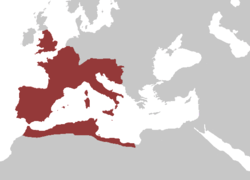Western Roman empire
| Roman Empire | |||||
|
Senatus Populusque Romanus Imperium Romanum |
|||||
| Western division of the Roman Empire | |||||
|
|||||
|
|
|||||
|
The Western Roman Empire at its greatest extent ca. AD 395
|
|||||
| Capital |
Mediolanum (286–402) Ravenna (402–476) |
||||
| Languages |
Latin (official) Koine Greek, Aquitanian, Gaulish, Common Brittonic, Gothic, Neo-Punic |
||||
| Religion |
Roman religion until 380 Christianity (state church) after 380 |
||||
| Government | , Tetrarchy (293–313) |
||||
| Emperor | |||||
| • | 395–423 | Honorius | |||
| • | 457–461 | Majorian | |||
| • | 475–476 | Romulus Augustulus | |||
| Consul | |||||
| • | 395 | Flavius Anicius Hermogenianus Olybrius, Flavius Anicius Probinus | |||
| • | 476 | Basiliscus, Flavius Armatus | |||
| Legislature | Roman Senate | ||||
| Historical era | Late Antiquity | ||||
| • | Division of Diocletianus | 285 | |||
| • | Division after Constantine I | 337 | |||
| • | Division by Valentinian I | 364 | |||
| • | Division after Theodosius I | 395 | |||
| • | Deposition of Romulus Augustus | 4 September 476 | |||
| Area | |||||
| • | 395 | 2,000,000 km² (772,204 sq mi) | |||
| Currency | Roman currency | ||||
| Today part of | |||||

Tremissis depicting Flavius Julius Nepos (474-480),
the de jure last Emperor of the Western Court
In historiography, the Western Roman Empire consists of the western provinces of the Roman Empire at any one time during which they were administered by a separate independent Imperial court, coequal with (or only nominally subordinate to) that administering the eastern half. Both "Western Roman Empire" and "Eastern Roman Empire" (or "Byzantine Empire") are modern terms describing de facto independent entities; however, at no point did Romans consider the Empire split into two, but rather considered it a single state governed by two separate Imperial courts out of administrative expediency. The view that the Empire was impossible to govern by one emperor was established by Diocletian following the disastrous civil wars and disintegration of the Crisis of the 3rd century, and was instituted in Roman law by his introduction of the Tetrarchy in AD 285, a form of government which was legally to endure in one form or another for centuries. The Western Court was periodically abolished and recreated for the next two centuries until final abolition by the Emperor Zeno in 480, by which time there was little effective central control left in the area legally administered by the Western Court.
...
Wikipedia

